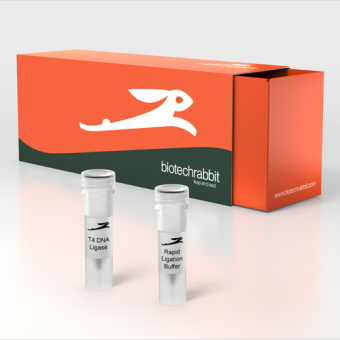Biotechrabbit은 바이오의약품 및 생명과학 연구를 위한 고급 실험 재료와 서비스를 제공하는 회사입니다.

제품 설명
T4 DNA Ligase Rapid, 600 U/µl
제품 번호
BR1100301
제품 특징
Description
biotechrabbit™ T4 DNA Ligase Rapid is an exceptionally pure, highly concentrated ligase for applications in which high enzyme concentrations are required. It is especially recommended for fast ligations.
T4 DNA Ligase Rapid is supplied with 5× Rapid Ligation Buffer containing PEG for fast 5–10 minutes ligation, ligation of low-concentration or blunt-end DNA.
T4 DNA Ligase catalyzes the formation of a phosphodiester bond between the terminal 5' phosphate and the 3' hydroxyl groups of duplex DNA or RNA. The enzyme efficiently joins blunt and cohesive ends and repairs single stranded nicks in duplex DNA, RNA or DNA–RNA hybrids.
Other Information
Component | Composition |
T4 DNA Ligase Rapid | T4 DNA Ligase Rapid, 600 U/µl, in storage buffer containing 50% (v/v) glycerol. |
5× Rapid Ligation Buffer | Optimized buffer including PEG for rapid ligation. |
STORAGE | -20°C (until expiry date – see product label) |
One unit of T4 DNA Ligase is defined as the amount of enzyme needed to ligate 50% of 100 ng of DNA fragments with cohesive ends in a 50 µl reaction mixture in 1× Ligase buffer incubated at 23°C for 30 minutes. Approximately 22 biotechrabbit cohesive end units are equivalent to one Weiss unit.
Protein purity is confirmed by SDS polyacrylamide gel electrophoresis followed by Coomassie Brilliant Blue staining. Purity is >95%.
Linearized lambda/HindIII DNA fragments are incubated with the enzyme in a 50 µl reaction mixture for 4 h at 37°C. No DNA degradation observed.
Supercoiled plasmid DNA is incubated with the enzyme in a 50 µl reaction mixture for 4 h at 37°C. No conversion of covalently closed circular DNA to nicked DNA detected.
Absence of E. coli genomic DNA is confirmed by qPCR using a sample of the enzyme and specific primers targeting the E. coli 16S rRNA gene. No contamination detected.
Protocols
Component | Volume | Final concentration |
5× Rapid Ligation Buffer | 10 µl | 1× |
Vector DNA | Variable | 1–10 ng/µl |
Insert DNA | Variable | 1–10 ng/µl |
T4 DNA Ligase, Rapid (600 U/ µl) | 1 µl | 30 U/µl |
Nuclease free water | Variable |
|
Total volume | 20 µl |
|
PEG at a high concentration significantly reduces the transformation efficiency of electrocompetent cells. Before electrotransformation, PEG should be removed by one of the following alternative approaches:
Biotechrabbit에서 다양한 제품을 찾아보세요!
Biotechrabbit - Official Distributor in South Korea "Morebio" 한국 공식 대리점 "모아바이오"